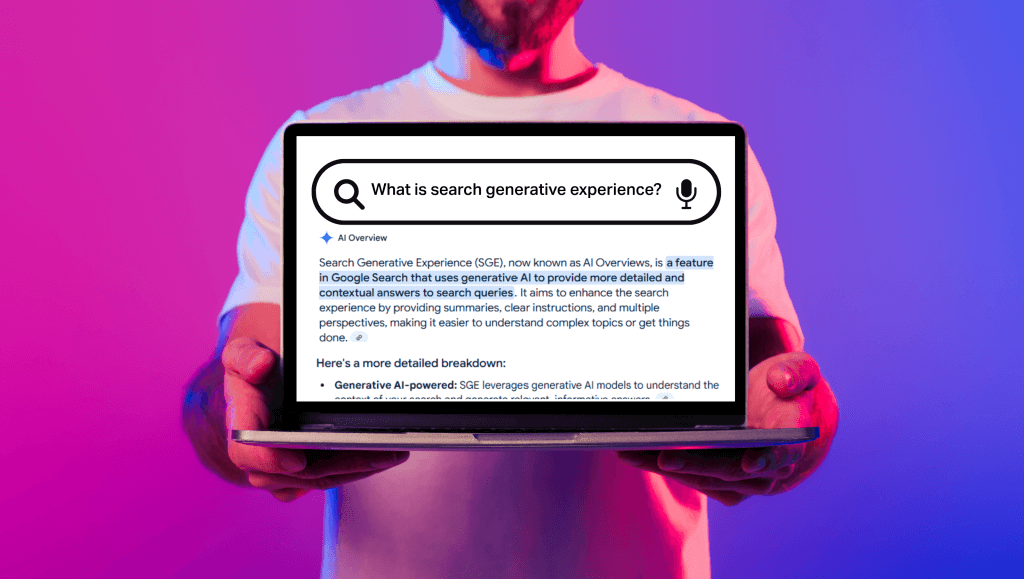Answer Optimization: How Publishers Win with SGE, ChatGPT, and AI-First Discovery

By Nick Sabean, VP/GM of Content Intelligence at Futuri
The Search Game Has Changed… Again
If you’re still optimizing content just to land on Page One, you’re not behind, you’re invisible.
Welcome to the AI-first discovery era, where algorithms summarize before they serve. And your content’s job? Be the answer — not the afterthought.
Platforms like Google’s Search Generate Experience (SGE), ChatGPT, Gemini, and Perplexity now determine what gets read, shared, or skipped. Editorial visibility is no longer about blue links. It’s about being cited, quoted, and trusted — by machines and humans alike.

What Is Search Generative Experience (SGE)?
SGE is Google’s AI-powered search experience that delivers AI-written summaries before traditional results appear. Instead of 10 blue links, users get:
- Direct AI-generated responses
- Key points pulled from multiple sources
- Follow-up questions and conversational search prompts
It’s a new front page, and your content needs to appear at the top.
What Are AI Answer Engines?
AI answer engines like ChatGPT, Gemini, Claude, and Perplexity are reshaping search behavior, especially among younger audiences. These tools skip the search engine middleman and deliver synthesized, conversational responses from web content… often without sending readers back to your site.
Why this matters: If your content isn’t part of these AI summaries, you’re missing the new front door to the web.
What Are AI Answer Engines?
AI answer engines, like ChatGPT, Perplexity, Gemini, and Claude, are tools users now turn to instead of search. They deliver conversational, synthesized answers from web content, sometimes without driving a click.
Key Data:
- This follows a recent HerCampus study finding that 74% of Gen Z internet users use TikTok for search, and 51% favor it over Google, primarily due to its short-form video format. (Emarketer)
- Google AI Overviews decrease CTRs by 34.5%, per new study. (Emarketer)
- About 59% of Gen Z (born 1997–2012) and 56% of Millennials (1981–1996) use them in at least half of their searches. (YouGov)

SEO vs. AEO: Welcome to Answer Engine Optimization
Traditional SEO-optimized content for Google’s crawler. Today’s winning strategy is AEO Answer Engine Optimization.
|
SEO (Search Engine Optimization) |
AEO (Answer Engine Optimization) |
|
Focuses on ranking |
Focuses on being cited, summarized, or answered |
|
Keywords + backlinks |
Structured answers + conversational phrasing |
|
Optimized for crawlers |
Optimized for AI models and language parsers |
|
Clicks and traffic |
Visibility and trust in AI summaries |
It’s no longer just about being clicked. It’s about being quoted.
5 Ways to Optimize Content for SGE and Chatbots
1. Create Structured, Scannable Content for Easy Parsing
AI rewards clarity, prioritizing content that can be parsed easily.
Tips:
- Use H2s and H3s with clear questions and answers
- Include FAQs, lists, summaries, and bolded takeaways
- Place key info in the first 100 words
2. Build Topic Authority and Interlinked Topical Clusters
Chatbots love expertise, favoring trusted, consistent sources.
Tips:
- Own specific verticals (e.g., local sports, tech trends, health updates)
- Publish multiple interlinked stories around each core topic
- Ensure bylines and expert sources are included
3. Implement Schema Markup
Structured data helps AI bots contextualize your content, making it machine-readable.
Use:
- Article, FAQPage, HowTo, Person, and Organization schema
- Metadata for author, publish date, and article type
4. Publish Original Insights and First-Party Data
AI engines don’t cite copycats, so ditch the generic content.
Try:
- Add original quotes, data points, or perspectives
- Include visual assets with alt text and licensing info
- Summarize findings at the top and bottom of the piece
5. Monitor AI Citations and Visibility
Track how and where your content is used in AI outputs. If it’s not cited, it’s not being seen.
Try:
- Search for your domain on Perplexity and ChatGPT
- Use tools like TopicPulse’s AI Signal Score
- Benchmark your stories’ inclusion in trending conversations

New Mindset, New Workflow: Editorial Teams Must Rethink the Workflow
Old mindset: Publish → Wait → Hope Google finds it.
New mindset: Predict → Structure → Summarize → Monitor → Repeat.
At Futuri, we built the TopicPulse Content Intelligence Suite to make this shift easier. TopicPulse helps publishers:
- Predict trending stories before AI bots do
- Auto-generate SGE/AEO – and chatbot-ready content
- Track content performance across social, search, and AI
Don’t Optimize for Clicks, Optimize for the Answer
This isn’t just a search algorithm update. It’s a shift in how content is discovered, interpreted, and trusted. This is more than SEO evolution; it’s editorial transformation.
If your editorial content isn’t structured to be the answer, AI tools won’t see it, and your audience won’t either.
The good news? Journalists, editors, and creators still own the story, the nuance, and the credibility. You just need to package it in a way AI can easily quote, cite, and understand.
Because in 2025, visibility starts before the reader even clicks.
About Nick Sabean
Nick Sabean is a bold force in AI-powered media innovation — the VP/GM behind TopicPulse and Futuri VoiceAI at Futuri Media. With a sharp eye for market opportunity and a proven playbook for growth, he’s helping transform how publishers, podcasters, and content creators stay relevant, monetize smarter, and move at the speed of culture. Whether he’s building a partner ecosystem, developing GTM campaigns, or crafting compelling narratives, Nick blends product depth, creative instinct, and operational savvy to lead from the front.





